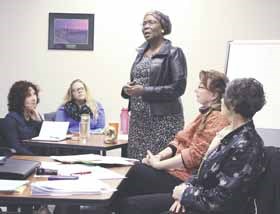From the time of the earliest European settlers, immigration has always been a source of tension in Canada. It is perhaps not all that surprising, then, that the recent influx of new immigrants might be stirring up new conflict.
It is enough of a concern the Multicultural Council of Saskatchewan (MCS), the Saskatchewan Association of Immigrant Settlement and Integration Agencies (SAISIA) and the Aboriginal Friendship Centres of Saskatchewan (AFCS) applied for, and received, provincial funding to research the issue.
The coalition brought its community consultation road show to Yorkton last week for a workshop, which attracted a diverse group of participants.
Darlene Stakiw of Yorkton is a past-president of the MCS who attended. She said it was an excellent opportunity to build bridges between two of the fastest growing communities in the province.
According to the 2011 National Household Survey, even as the First Nations population is increasing at a rapid pace, immigration is moving even faster.
There are now approximately half as many new immigrants in Yorkton-mostly Filipino and Southeast Asian-as there are Aboriginal people.
In Saskatchewan's two biggest cities, the immigrant population has surpassed the Indigenous population.
Both groups remain visible minorities to the largely white, European-descended majority. Recent immigrants often compete with First Nations people for entry-level jobs and affordable housing. They also don't have the historical sensitivity to First Nations issues as many Euro-Canadians do.
The potential for conflict can be exacerbated, Stakiw said, by the tendency for both groups to keep to themselves. Newcomers can be influenced by negative cultural stereotypes about Aboriginals and First Nations members are frequently exposed to the perception that immigrants are getting preferential treatment from the government.
Stakiw was very encouraged by workshop, however, which brought in representatives from the Yorkton Newcomer Welcome Centre, the Yorkton Friendship Centre, the City of Yorkton, the Yorkton Public Library, Parkland Valley Sport Culture and Recreation the Painted Hand Casino, the Saskatchewan Band Association and others. There was even a group that came all the way from Swift Current to take part.
"There's more positives going on here than negatives," Stakiw said.
She cited some examples including the Yorkton Friendship Centre welcoming newcomers to its free income tax service and its pro bono legal clinic. The casino has hired a number of newcomers, as well.
The coalition hired Flo Frank from the Common Ground Resource Group in Meacham, Saskatchewan, to facilitate. Frank is a specialist in diversity and inter-cultural transitions and author of numerous publications including The Community Development Handbook and The Community Development Facilitator's Guide, which she co-authored with Anne Smith for Human Resources Canada.
She said the session was instructional.



